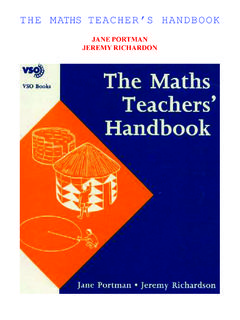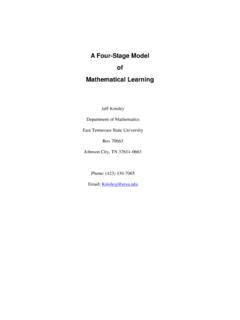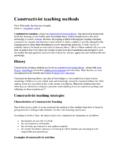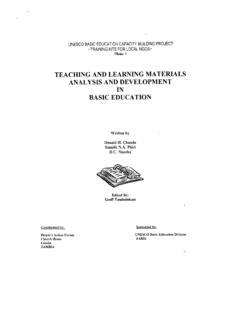Transcription of COOPERATIVE LEARNING IN MATHEMATICS
1 COOPERATIVE LEARNING IN MATHEMATICSA uthor(s): Roza Leikin and Orit ZaslavskySource: The MATHEMATICS Teacher, Vol. 92, No. 3 (MARCH 1999), pp. 240-246 Published by: National Council of Teachers of MathematicsStable URL: .Accessed: 22/10/2013 22:17 Your use of the JSTOR archive indicates your acceptance of the Terms & Conditions of Use, available at ..JSTOR is a not-for-profit service that helps scholars, researchers, and students discover, use, and build upon a wide range ofcontent in a trusted digital archive. We use information technology and tools to increase productivity and facilitate new formsof scholarship. For more information about JSTOR, please contact .National Council of Teachers of MATHEMATICS is collaborating with JSTOR to digitize, preserve and extendaccess to The MATHEMATICS This content downloaded from on Tue, 22 Oct 2013 22:17:52 PMAll use subject to JSTOR Terms and Conditionsi Connecting Research to teaching Roza Leikin and Orit Zaslavsky COOPERATIVE LEARNING IN MATHEMATI Students mutually and positively depend on one another How can the teacher best organize and manage the classroom during coop erative work so that discipline prone problems do not arise, interaction between students primarily involves task, and pupils still have sufficient freedom to contribute and to participate in the group discussion?
2 (Good, Mulryan, and McCaslin 1992,185) this article we describe a method of implementing a COOPERATIVE - LEARNING setting that we call exchange of knowledge. The design meets the goals suggested by Good, Mulryan, and McCaslin and gives stu dents an opportunity to gain experience with some LEARNING material and then to explain it to others. This method was developed on the basis of guide lines for COOPERATIVE LEARNING in MATHEMATICS class rooms (Arhipova and Sokolov 1988). This setting was implemented and investigated for a variety of MATHEMATICS topics in secondary school with stu dents of different age groups and ability levels in MATHEMATICS (Leikin 1993; Leikin and Zaslavsky 1997). We hope that our discussion of the exchange of-knowledge method will furnish specific sugges tions for promoting COOPERATIVE LEARNING in your classroom, as well as a framework for considering the issues involved in evaluating COOPERATIVE LEARNING methods in general.
3 WHAT IS COOPERATIVE LEARNING ? Davidson (1990a) notes that it is difficult to precise ly define COOPERATIVE LEARNING because of the large variety of LEARNING settings that are regarded as facilitating COOPERATIVE LEARNING and the differences among them. However, on the basis of information in Artzt and Newman (1990) and Sutton (1992), we propose four necessary conditions that together constitute a COOPERATIVE - LEARNING setting: Students learn in small groups with two to six members in a group. The LEARNING tasks in which students are engaged require that the students mutually and positively depend on one another and on the group's work as a whole. The LEARNING environment offers all members of the group an equal opportunity to interact with one another regarding the LEARNING tasks and encourages them to communicate their ideas in various ways, for example, verbally.
4 Each member of the group has a responsibility to contribute to the group work and is accountable for the LEARNING progress of the group. To be COOPERATIVE , a LEARNING setting should en sure the existence of all these conditions. Contrary to common belief, forming groups in the classroom is not sufficient to create a genuine COOPERATIVE LEARNING setting. Of the four conditions, we consider the third to be particularly significant (Bishop 1985; Clement 1991; Jaworski 1992). THE EXCHANGE-OF-KNOWLEDGE METHOD We turn to a detailed description, based on Leikin (1993) and Leikin and Zaslavsky (1997), of the Edited by Thomas Dick or st. edu Oregon State University Corvallis, OR 97331-4605 Penelope H. Dunham Muhlenberg College Allentown, PA 18104 Roza Leikin, is a teaching associ ate at the Technion?
5 Israel Institute of Technology. She is interested in COOPERATIVE - LEARNING processes, advanced mathematical thinking, and preservice and in-service MATHEMATICS teacher education. This article was written while she was a post-doctoral associate at LRDC?Univer sity of Pittsburgh. Orit Zaslavsky, is a senior lecturer at the Technion?Israel Institute of Tech nology. She is particularly interested in professional devel opment of secondary MATHEMATICS teachers and teacher educators and in LEARNING processes that motivate and enhance mathematical thinking and reasoning. 240 THE MATHEMATICS TEACHER This content downloaded from on Tue, 22 Oct 2013 22:17:52 PMAll use subject to JSTOR Terms and Conditionsexchange-of-knowledge method. This LEARNING method shares some characteristics with the jigsaw method (Aronson et al.)
6 1978) in that it gives stu dents an opportunity to play the role of a teacher and to offer explanations to their peers. However, the exchange-of-knowledge method also allows stu dents to work individually when appropriate. In addition, the tasks are designed to have students work in pairs to ensure that every student has the opportunity to both study and teach each type of LEARNING material. The LEARNING setting presented in this article resembles some features of Slavin's (1987) team assisted individualization program, which fosters students' individual work within larger groups and encourages them to check and help each other when necessary by using given answer sheets. However, the proposed method develops more com plex problem-solving and explaining activities.
7 All students have to explain to one another mathemati cal ideas and principles, figure out for themselves how to solve problems, and decide on the acceptable or correct answers. Description of the LEARNING setting The method is based on study cards and is carried out as follows: Most of the time, students learn in pairs within a larger group of four students. Each student is required to explain to his or her partner how to solve the worked-out example in which the student has gained expertise on the previous card and to listen to the explanations given by the partner on how to deal with the worked-out example on a new card. Each student is required to solve a problem similar to the previous worked-out example that the student's partner explained to the student?
8 And is entitled, if needed, to ask the partner? who already tackled the problem?for help in solving it. After completing the work on a pair of cards, stu dents change partners within the group. This move gives each group member an opportunity to act in the role of both a student and a teacher. Guidelines for preparing a set of study cards Each set of cards constitutes a LEARNING unit. Each set consists of two, four, or six study cards. The order in which the cards can be applied is not important. Figures 1 and 2 show examples of LEARNING cards. Each card consists of two or three parts. Part 1 consists of a worked-out example. The extent of the explanations on the card depends on the students' level and on their LEARNING experience in the topic. Part 2 includes a problem similar to the worked-out Card 1 Relationship between a Function and Its Derivative Function Part I?
9 Example Problem: The given graph represents the distance traveled by a car as a function of time. Draw a graph of speed of the car as a function of time. Explanation: Speed is the rate of change of the dis tance over an interval of time..AS An average speed is va = At Instantaneous speed is v? = lim 4^ = S'. *->0 At Instantaneous speed (rate of change of distance) is a slope of a graph of distance. Solution: i; (km/min) 10 20 t (min) 50 t (min) On the first segment: AS = 10. At 10' On the second segment: ^?- = ^ = 0 t zu 1u On the third segment: ^ = = ? ou ? zu S (km) Part II?Solve a problem Problem: The given graph represents the distance traveled by a car as a function of time. Of the following graphs of functions, which could represent the speed of the car in this trip?
10 40 t (min) (km/min? (km/min) t (min) t (min) (km/min) (km/min) ^40 80 t (min) t (min) Fig. 1 Example of a working card (card 1) example on the first part of the card, for students' individual solutions. Part 3, if appropriate, includes an additional problem to be solved by more advanced students. For each study card a corre sponding homework card is available. Arrangement of LEARNING within a classroom The LEARNING setting is divided into two main stages, as shown in figure 3: groups of experts and groups for exchange of knowledge. Vol. 92, No. 3 ? March 1999 241 This content downloaded from on Tue, 22 Oct 2013 22:17:52 PMAll use subject to JSTOR Terms and ConditionsCard 2 Relationship between a Function and Its Derivative Function Part I?Example Problem: The given graph represents the speed of a car as a function of time.)













